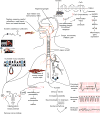TRPA1: Acrolein meets its target
- PMID: 28284857
- PMCID: PMC5528158
- DOI: 10.1016/j.taap.2017.03.007
TRPA1: Acrolein meets its target
Figures

Comment on
-
Role of TRPA1 in acute cardiopulmonary toxicity of inhaled acrolein.Toxicol Appl Pharmacol. 2017 Jun 1;324:61-72. doi: 10.1016/j.taap.2016.08.028. Epub 2016 Aug 31. Toxicol Appl Pharmacol. 2017. PMID: 27592100 Free PMC article.
-
TRPA1 mediates changes in heart rate variability and cardiac mechanical function in mice exposed to acrolein.Toxicol Appl Pharmacol. 2017 Jun 1;324:51-60. doi: 10.1016/j.taap.2016.10.008. Epub 2016 Oct 13. Toxicol Appl Pharmacol. 2017. PMID: 27746315 Free PMC article.
Similar articles
-
Acrolein relaxes mouse isolated tracheal smooth muscle via a TRPA1-dependent mechanism.Biochem Pharmacol. 2014 May 1;89(1):148-56. doi: 10.1016/j.bcp.2014.02.009. Epub 2014 Feb 19. Biochem Pharmacol. 2014. PMID: 24561178
-
TRPA1 mediates changes in heart rate variability and cardiac mechanical function in mice exposed to acrolein.Toxicol Appl Pharmacol. 2017 Jun 1;324:51-60. doi: 10.1016/j.taap.2016.10.008. Epub 2016 Oct 13. Toxicol Appl Pharmacol. 2017. PMID: 27746315 Free PMC article.
-
Human exposure to acrolein: Time-dependence and individual variation in eye irritation.Environ Toxicol Pharmacol. 2016 Jul;45:20-7. doi: 10.1016/j.etap.2016.05.011. Epub 2016 May 13. Environ Toxicol Pharmacol. 2016. PMID: 27235799 Clinical Trial.
-
Transient receptor potential ankyrin 1 (TRPA1) antagonists.Pharm Pat Anal. 2015;4(2):75-94. doi: 10.4155/ppa.14.60. Pharm Pat Anal. 2015. PMID: 25853468 Review.
-
Recent advances in the biology and medicinal chemistry of TRPA1.Future Med Chem. 2010 May;2(5):843-58. doi: 10.4155/fmc.10.29. Future Med Chem. 2010. PMID: 21426205 Review.
Cited by
-
TRPA1 and CGRP antagonists counteract vesicant-induced skin injury and inflammation.Toxicol Lett. 2018 Sep 1;293:140-148. doi: 10.1016/j.toxlet.2018.03.007. Epub 2018 Mar 10. Toxicol Lett. 2018. PMID: 29535050 Free PMC article.
-
Potential Adverse Public Health Effects Afforded by the Ingestion of Dietary Lipid Oxidation Product Toxins: Significance of Fried Food Sources.Nutrients. 2020 Apr 1;12(4):974. doi: 10.3390/nu12040974. Nutrients. 2020. PMID: 32244669 Free PMC article.
-
Molecular Binding Contributes to Concentration Dependent Acrolein Deposition in Rat Upper Airways: CFD and Molecular Dynamics Analyses.Int J Mol Sci. 2018 Mar 27;19(4):997. doi: 10.3390/ijms19040997. Int J Mol Sci. 2018. PMID: 29584651 Free PMC article.
-
Odor perception and symptoms during acrolein exposure in individuals with and without building-related symptoms.Sci Rep. 2022 May 17;12(1):8171. doi: 10.1038/s41598-022-12370-7. Sci Rep. 2022. PMID: 35581334 Free PMC article.
-
Toxic effects of chlorine gas and potential treatments: a literature review.Toxicol Mech Methods. 2021 May;31(4):244-256. doi: 10.1080/15376516.2019.1669244. Epub 2019 Oct 1. Toxicol Mech Methods. 2021. PMID: 31532270 Free PMC article. Review.
References
-
- Alarie Y. Sensory irritation by airborne chemicals. CRC Crit. Rev. Toxicol. 1973;2:299–363. - PubMed
-
- Andre E, Campi B, Materazzi S, Trevisani M, Amadesi S, Massi D, Creminon C, Vaksman N, Nassini R, Civelli M, Baraldi PG, Poole DP, Bunnett NW, Geppetti P, Patacchini R. Cigarette smoke-induced neurogenic inflammation is mediated by alpha,beta-unsaturated aldehydes and the TRPA1 receptor in rodents. J. Clin. Invest. 2008;118:2574–2582. - PMC - PubMed
-
- Balakrishna S, Song W, Achanta S, Doran SF, Liu B, Kaelberer MM, Yu Z, Sui A, Cheung M, Leishman E, Eidam HS, Ye G, Willette RN, Thorneloe KS, Bradshaw HB, Matalon S, Jordt SE. TRPV4 inhibition counteracts edema and inflammation and improves pulmonary function and oxygen saturation in chemically induced acute lung injury. Am. J. Physiol. Lung Cell. Mol. Physiol. 2014;307:L158–L172. - PMC - PubMed
-
- Bandell M, Story GM, Hwang SW, Viswanath V, Eid SR, Petrus MJ, Earley TJ, Patapoutian A. Noxious cold ion channel TRPA1 is activated by pungent compounds and bradykinin. Neuron. 2004;41:849–857. - PubMed
Publication types
MeSH terms
Substances
Grants and funding
LinkOut - more resources
Full Text Sources
Other Literature Sources

